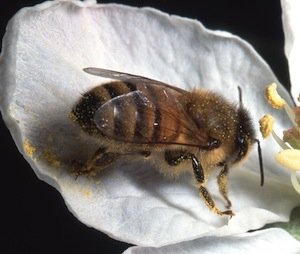 Beekeepers who took their bees to California to pollinate almonds report worse bee losses than those who did not.
Beekeepers who took their bees to California to pollinate almonds report worse bee losses than those who did not.
Losses of colonies of managed honeybees were 31.1 percent for the winter of 2012-2013, a level higher than the previous winter, according to the annual survey conducted by the Bee Informed Partnership and the Apiary Inspectors of America. The report was released May 10.
Losses in the winter of 2011-2012, at 22 percent, were the lowest since the arrival of colony collapse disorder in 2006, creating some optimism. But losses last winter were slightly above the six-year average loss of 30.5 percent. By one estimate, 10 million hives of honeybees, with a replacement value of $200 each, have died since 2006, and the $2 billion loss has been borne by beekeepers.
The survey covered October 2012 to April 2013, during which more than 6,000 beekeepers responded. It was conducted by University of Maryland research scientist Dr. Dennis vanEngelsdorp, who is also director of the Bee Informed Partnership, and Jeff Pettis, research leader of the U.S. Department of Agriculture’s Agricultural Research Service Bee Research Laboratory in Beltsville, Maryland.
Release of the survey data came the same week as release of a new comprehensive scientific report on honeybee health from the USDA and the U.S. Environmental Protection Agency. That report reaffirmed the belief that multiple factors play a role in honeybee colony declines, including parasites and disease, genetics, poor nutrition, and pesticide exposure. One difference noted in the survey of last winter’s losses was that more colonies dwindled away, rather than suddenly disappearing, as happens with colony collapse disorder (CCD). That was a repeat of the previous year’s experience.
Another major difference showed that beekeepers who later took honeybees to California to pollinate almonds reported higher losses than beekeepers who did not take their bees to pollinate almonds. Nearly 20 percent of the beekeepers who pollinated almonds lost 50 percent or more of their colonies, according to vanEngelsdorp. Some 70 percent of responding beekeepers reported losses greater than 14 percent, a level of loss considered the most beekeepers can sustain and remain economically viable.
In the USDA/EPA report, key findings included:
Parasites and disease: The parasitic varroa mite is the major factor underlying colony loss in the United States and other countries. There is widespread resistance to the chemicals beekeepers use to control mites within the hive. New virus species have been found in the United States, and several of these have been associated with CCD.
Genetic diversity: U.S. honeybee colonies need increased genetic diversity. Honeybee breeding should emphasize traits such as hygienic behavior that confer improved resistance to Varroa mites and diseases such as American foulbrood.
Poor nutrition: Nutrition has a major impact on individual bee and colony longevity. Bees need better forage and a variety of plants to support colony health. “Federal and state partners should consider actions affecting land management to maximize available nutritional forage to promote and enhance good bee health and to protect bees by keeping them away from pesticide-treated fields,” the report says.
Information sharing: Best management practices associated with bees and pesticide use exist, but are not widely or systematically followed by members of the crop-producing industry, the report says. “There is a need for informed and coordinated communication between growers and beekeepers and effective collaboration between stakeholders on practices to protect bees from pesticides.”
Pesticides: “The most pressing pesticide research questions relate to determining actual pesticide exposures and effects of pesticides to bees in the field and the potential for impacts on bee health and productivity of whole honeybee colonies,” the report says.

Leave A Comment